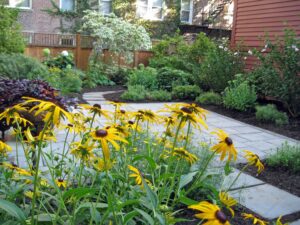RIGHT PLANT, RIGHT PLACE, RIGHT CARE AT THE RIGHT TIME

Fine organic gardening is the practice and skill of using low-input, organic methods to design, install and maintain ornamental horticulture gardens for the benefit of people, pets and pollinators – and the web of life at large. This garden view in Cambridge, MA features native black-eyed Susans in mid to late summer, which is the yellow petaled native perennial in the foreground.
FIRST, DO NO HARM Every decision you make has an impact on the ecosystem that is your property, your neighbors’ properties, your local drinking water supply, your community and property values.
ORGANIC PRACTICES BENEFIT YOU PERSONALLY, such as:
- GREATER SAFETY for YOU, YOUR FAMILY and PETS Organic garden and landscape practices and products are generally regarded as safer for children, pets and the environment, when properly applied. Many conventional landscape treatments are chemicals that are derived from petroleum, and many are known or suspected hazards.
- ROBUST LANDSCAPE SUSTAINABILITY Organic landscape and design practices will give your plants the best chance to thrive in your existing soil, sun, weather and other cultural conditions, with minimal inputs of time and other resources.
- SAVE TIME and MONEY With proper plant selection and care, you can save time for other favorite activities, skip the expensive conventional fertilizers and lower your water bills.
Additional benefits include:
- HAVE A BETTER LAWN Your lawn is comprised of cool season turf grasses, which are plants after all, and they’ll be more robust with organic practices such as
- greenscycling (leaving your grass clippings on the lawn, rather than bagging and removing them, when mowing;
- mow to a 3 to 4 inch height
- water deeply once a week (if at all) to increase root penetration; perhaps twice a week if you must during the hot summer months; turf grasses are cool season plants and don’t like hot summers at all
- top dress your lawn with 1/4 inch of compost (organic matter) every fall. Alternatively, chop up fallen deciduous leaves with your mower and distribute them evenly on your lawn as a source of free organic matter
- have your soil tested every two to three years to determine what nutrients may be lacking or overabundant
- overseed bare spots in September
- have high compaction areas aerated with a core aerator as needed
- CHEMICAL PESTICIDES HAVE THE POTENTIAL TO CAUSE DAMAGE THROUGHOUT THEIR LIFE CYCLES, including their production, transportation, storage, use and disposal
- ORGANIC PRACTICES INCREASE THE BIODIVERSITY OF YOUR LAND Incorporating native plants, you’ll have increased activity of beneficial organisms above and below ground. This means that more nutrients and water are naturally available to your plantings when they are needed most. Above ground, beneficial insects are better able to pollinate as well as patrol and control insect pest populations naturally. Where you have more insects, you’ll have more birds and a more robust ecosystem.
AFTER MANUAL WEED CONTROL, A GARDEN PATH APPEARS in SHARON, MA:

A WEED IN TIME SAVES NINE – OR THOUSANDS. Regular maintenance of your landscape helps prevent overwhelming weed situations like this one. An every-other week maintenance schedule can prevent weeds from taking over. Correctly identifying and knowing the life cycle of your problem—and desired—plants is the key to managing them.
